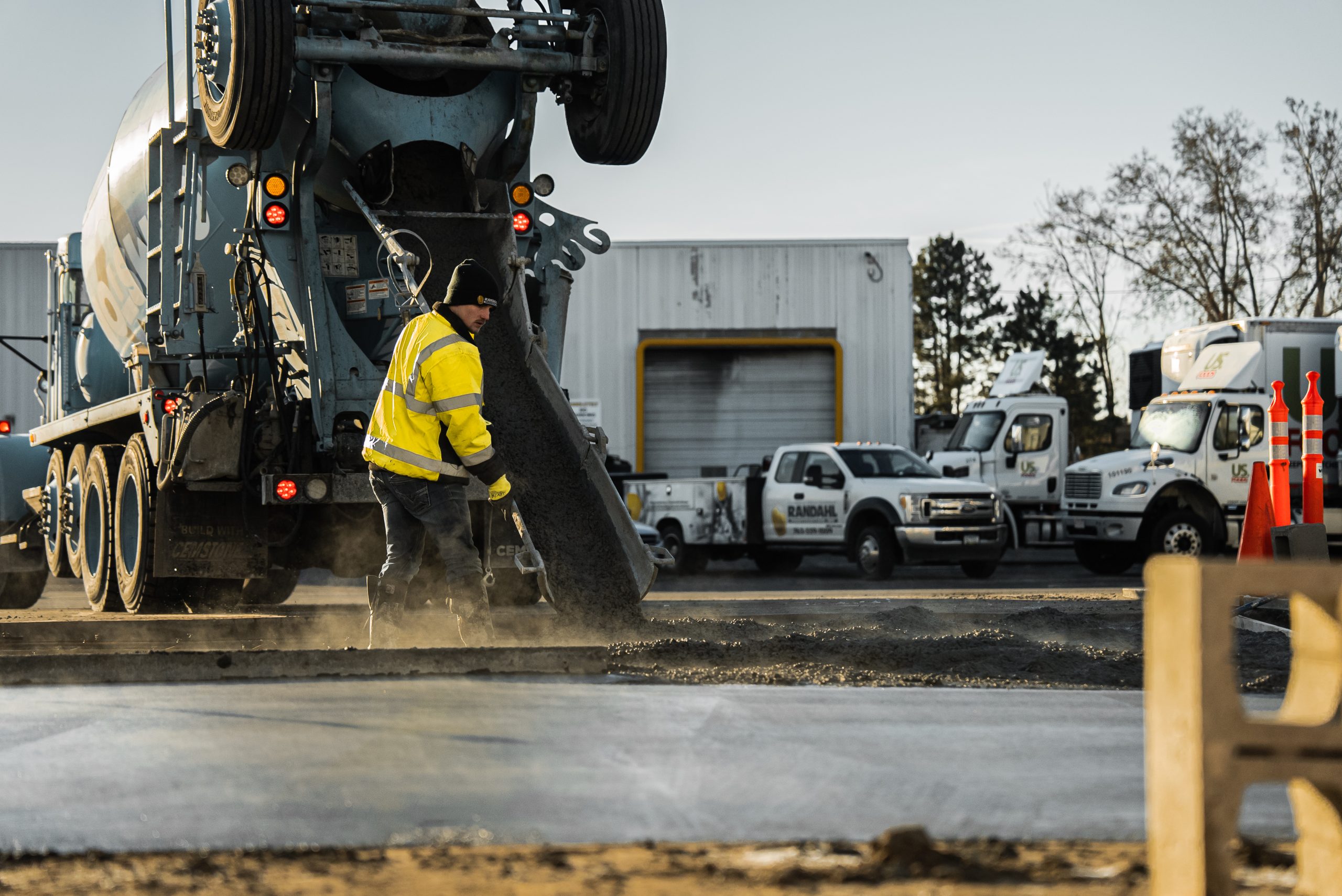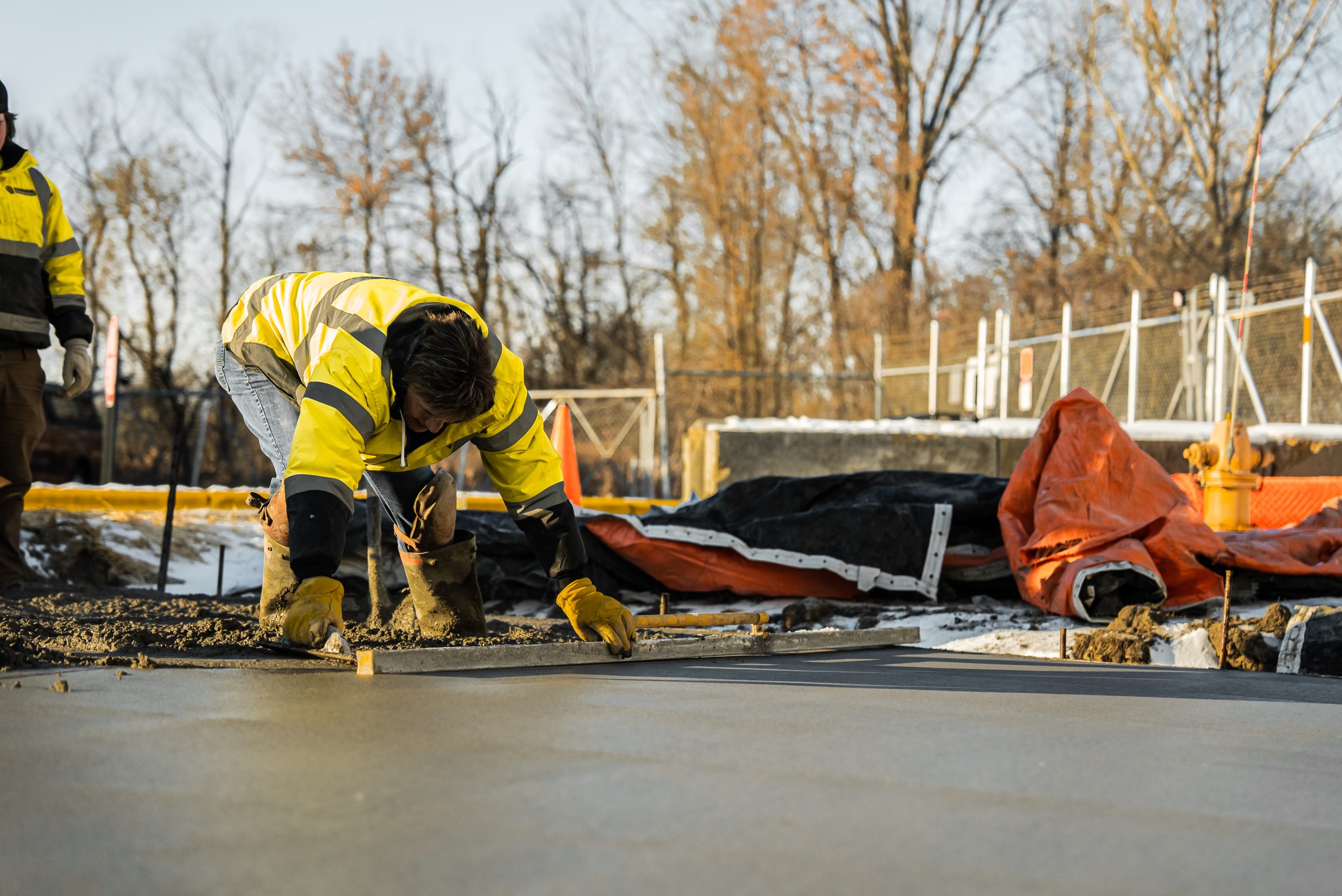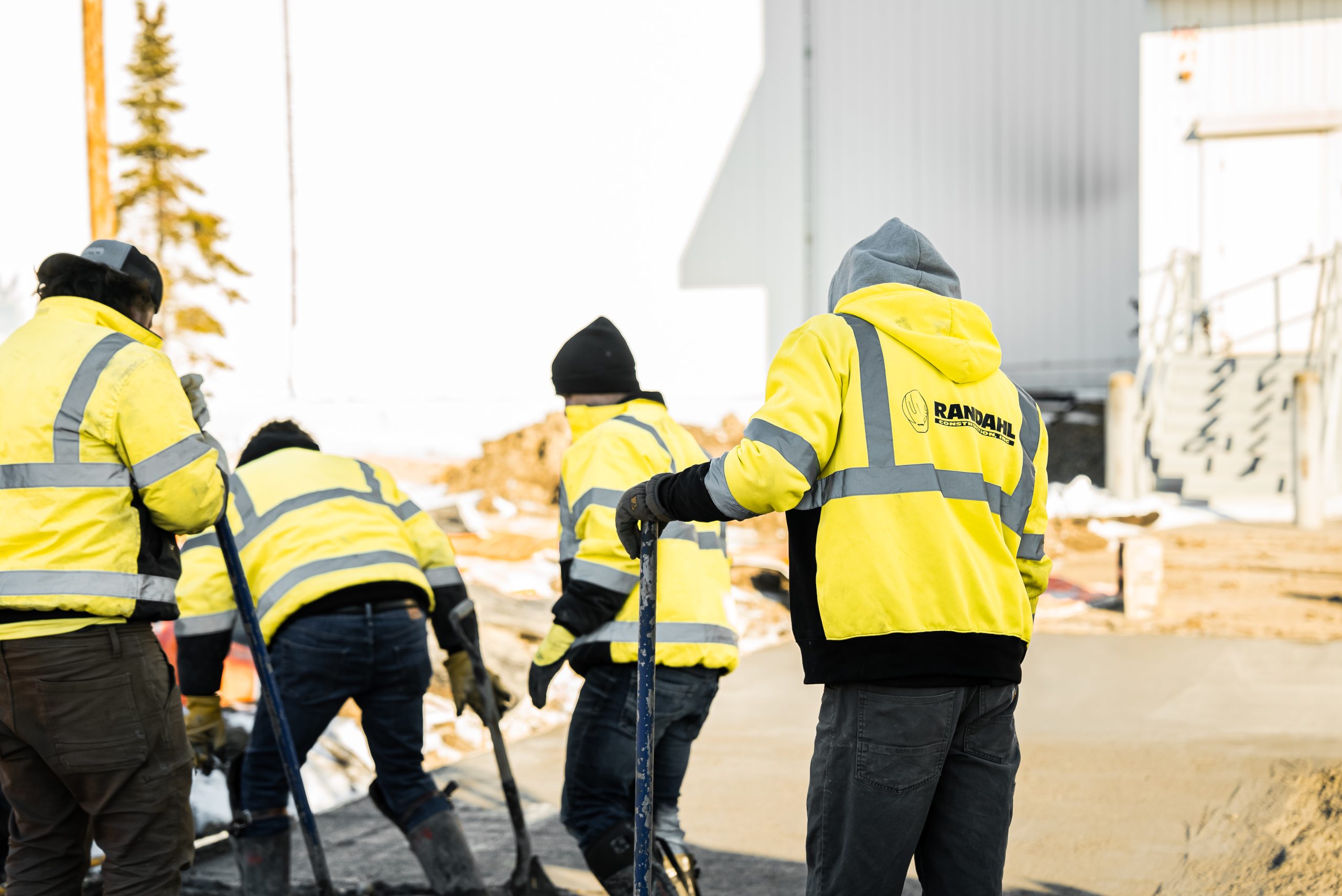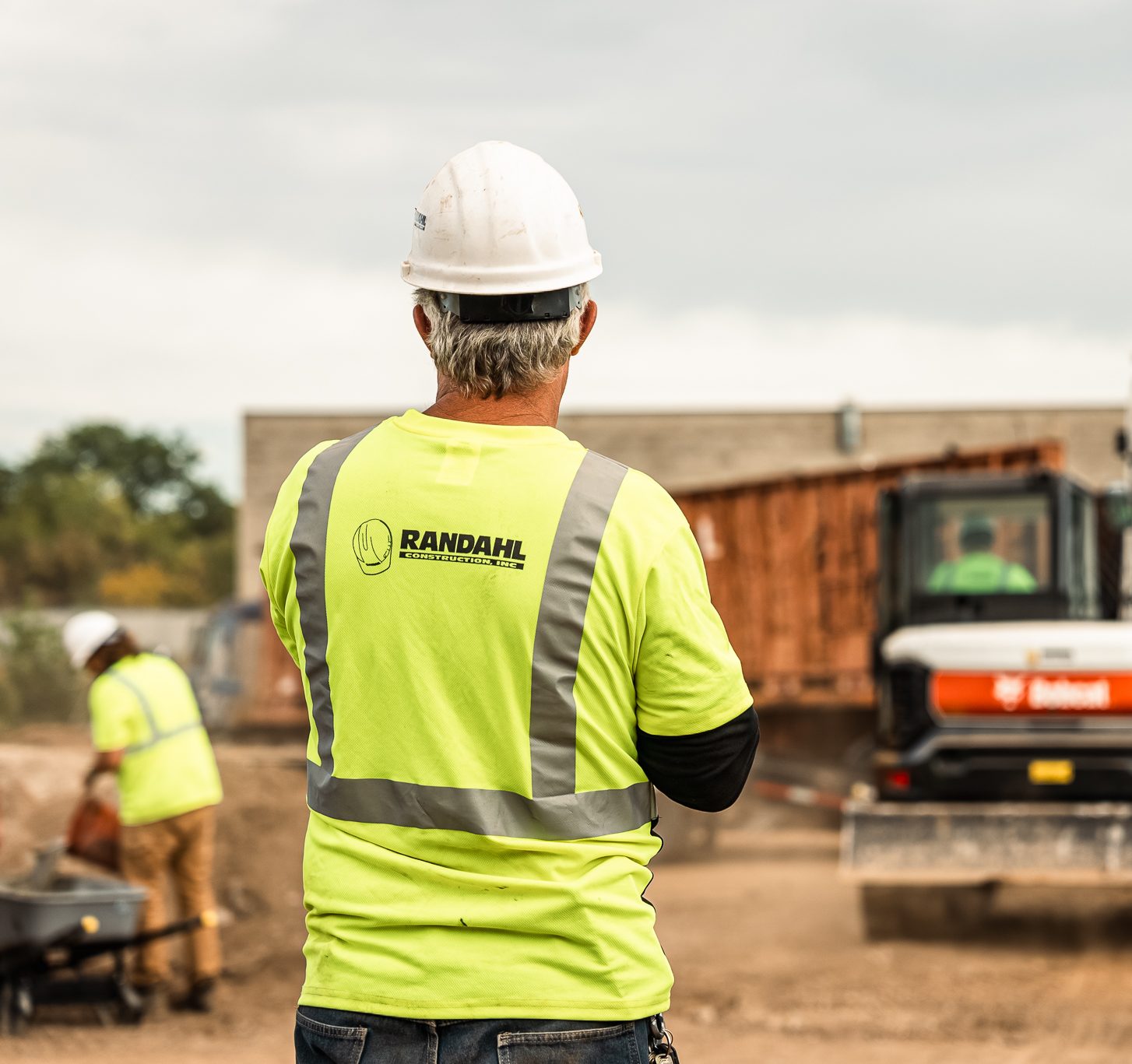Concrete is made of a mixture containing rocks, or a collection of sand, gravel, crushed stone, slag, or recycled crushed concrete, also known as concrete aggregates and water. This mixture coats the surface of the concrete with fine small or large coarse aggregates. Then as it begins to dry, the mixture becomes hard and firm, forming a rock-like mass.
Concrete is usually mixed at a local concrete manufacturer near the construction project site. It is then transported in cement mixing trucks to the location, continuously moving and mixing along the way.
Since every project is unique, the preparation of the job site differs from one project to the next. But, there is an essential process for site preparation. We usually start by removing the top layer of soil and surface vegetation. Then, we excavate the high areas of the grade and fill them as needed.
Once we pour the concrete, the curing process begins. At this point, it is important to maintain a specific temperature and protect the concrete from moisture loss. This will make the concrete stronger and decrease its permeability. The curing process is vital to minimizing future cracking in the concrete.
Timing is essential to a successful concrete project. At Randahl Construction, Inc., we are proud of our track record for successfully coordinating our concrete projects with the client’s other projects at the site. We have earned a reputation for finishing our projects on time and within budget. Late deliveries, poor communication, and rushed work are unacceptable at Randahl Construction, Inc.
Communication between the cement trucks and our construction crew is vital to our success. Some of our leading manufacturers have satellite technology in their cement delivery trucks, allowing our job-site team to have precise delivery times.
Concrete has been a valuable resource for ages, dating back to ancient times when a form of concrete was made from volcanic ash and hydrated lime. Although many years have passed and some advancements have been made, industrial concrete is typically made in a few primary forms depending on the different applications and purposes.

Concrete Slabs are the structural elements of a building. They usually range from 4” to 20” thick and create floors and ceilings in industrial structures.
To provide tensile strength, commercial concrete contractors can combine concrete with supporting materials, such as rebar, steel, or other polymers, preventing unacceptable cracking and/or structural failure.
Accelerated concrete is used for roads and highways where quick drying is essential. To speed up the drying process, we use a unique technology.
Pervious concrete is manufactured to reduce water runoff. Pervious concrete contains no fine sand, allowing water to pass through it, filtering heavy metals, suspended solids, and even petroleum products. This environmentally friendly feature means that the harmful sediments in rain/storm water are filtered out, resulting in better quality water for the land beneath. While pervious concrete is not as strong structurally as standard concrete, it can be used in light-duty applications or areas with less traffic, such as parking ramps or neighborhood streets.
Ready-mixed concrete is the most common type of concrete used today. This is the type of concrete we at Randahl Construction, Inc. use in most of our commercial remodeling and construction projects.
Ready-mixed concrete is batched locally here in Minnesota and distributed to our different project sites and locations. When you see cement mixer trucks traveling on the road, they are carrying ready-mixed concrete from the concrete batching plant, which is pre-mixed to the job site where it will be laid by the concrete contractor.
This ready-mix concrete is commonly found in sidewalks, warehouse floors, concrete slabs, etc. Ready-mixed concrete is preferred over on-the-site concrete mixing because of the precision needed when mixing the components.
Precast concrete is a component cast in a factory setting where it can be carefully watched and crafted. Precast components are typically structural wall panels, stadium risers, bricks, and paving stones.
Precast Concrete is also known as architectural and decorative concrete. It can offer high strength capacity to support building structures combined with attractive customizations such as colored concrete, exposed aggregate, and more.
When the concrete is poured horizontally on the job site and then tilted up or tilted into place, it is called tilt-up concrete, tilt-slab, tilt-wall, or tilt-up concrete. The ceiling, floors, and other walls are then constructed similarly and connected, supporting one another.
Industrial concrete standards are based on

The PSI (Pounds Per Square Inch) number in industrial concrete, typically 4000 psi, 3500 psi, or 3000 psi, offers the compression strength of the product and its resistance to downward force in the PSI. The PSI number is the official number given with 28 days of curing, also known as the “28-Day Compressive Strength.” The key to achieving robust and high-capacity concrete is proper proportioning and mixing of its ingredients.
The hardness of concrete can be determined by the type of aggregate used in the mixture.
Elasticity is the ability of the material to resume its standard shape after being compressed. When discussing concrete elasticity, we refer to how the concrete reacts under stress. Typically the elasticity of concrete is relatively consistent at low-stress levels but begins to lower at increased stress levels as matrix cracking develops.
Concrete workability refers to how well the concrete can be poured, laid, and placed into the proper location. Workability is essential depending on the type of concrete project at hand. On the job, The Slump Test can be used to test the concrete’s workability. The test is done with a cone-shaped object on the construction site that is filled with concrete, then flipped over and eventually revealing how much slumping is in the concrete.
Each of these properties is affected by adjustments made to the different materials in the mixture. ASTM, ACI, and local business codes create and maintain industrial concrete standards.
Contractors must always understand what type of soil materials are underneath the concrete area during preparation. Knowing the moisture, density, and overall flatness of the surface that the concrete will rest on is the key to the overall performance of the concrete slab.
With the proper knowledge of the soil, contractors can then use the correct compactors for the job depending on those variables. Typically, graders prepare the site to a rough grade, and then the concrete team takes care of the final preparation of the fine grading in the top few layers.
As with all construction projects, communication is key in this process, ensuring all team members are on the same page. It is easy to blame poor performance or failure on the concrete, but problems also arise from poor soil preparation for the concrete to rest on.

Although rare, problems and defects can occur due to concrete. As a customer, you should always be aware of the worst-case scenarios in a concrete project, so you can protect yourself.

Blisters are the small, medium, and large size bumps that come to the surface of the concrete after curing if there is too much air left in the concrete. This can happen during the compaction process or finishing process if it is done at the wrong time.
Sometimes, minor shrinkage occurs on the top levels of the surface when curing. This results in fine surface cracks that are visible but don’t penetrate the surface.
When there is a temperature difference between the top of the concrete top and the bottom, the edges or corners will rise up or become distorted.
This occurs after the project is complete and the dust settles on the top surface of the concrete. This dust can be wiped off with a fingertip. The dusting found on the surface of the concrete is composed of cement, water, and fine particles, and it is called laitance.
Low spots are concrete areas that aren’t level with the rest of the surface. These low spots can affect drainage and are typically from poor lighting during the finishing process and also can be caused by errors in the forms and screeds set up. Overly wet concrete can also cause low spots of concrete.
When your concrete is exposed to freezing and thawing, concrete will lose surface mortar. This is called scaling.
Spalling is similar to scaling. It can happen for several reasons: corroded steel in the reinforcement, impact loads, fire, or weathering.
Cracking in the concrete surface can result from drying shrinkage, thermal contraction, restraint, subgrade settlement, and loads applied to the concrete.
Delamination happens on the surface of the finished concrete. Similar to blisters, delamination is described as two levels separating. This happens when concrete from bleed water and bleed air is trapped below the prematurely closed mortar surface.
Discoloration is when large or small areas of the concrete surface are a different color than the rest. There are so many factors that can affect the color of concrete. No one variable can account for all concrete discoloration.
Efflorescence is a white deposit that appears once the concrete project is complete. When efflorescence is present, a concrete contractor or expert should be notified.
A popout on a concrete flooring project happens when a small piece of the concrete flooring surface pops out of place. This does not typically affect the life of the concrete and is considered a cosmetic detraction.
Our concrete manufacturers are located all around Minnesota. They have extensive experience mixing concrete designs to withstand our harsh Minnesota winters and warm summers.
Through years of labor, research, and testing, Cemstone, one of our leading manufacturers, engineers exterior concrete, has engineered a concrete solution offering a mixture of concrete that provides an aesthetically pleasing product while lasting longer and requiring less maintenance. This shows our customers a lower lifetime cost on their concrete parking surfaces.

Based in Minnesota, Randahl Construction, Inc. has dealt with cold weather for over 37 years. We can perform concrete work in even the coldest weather as long as we take the appropriate precautions. The objectives are to prevent damage from early-age freezing (when the concrete is still saturated), to ensure the concrete develops the needed strength, and to limit rapid temperature changes or large temperature differentials that cause cracking. Although there is some cost to all this, it’s typically not excessive— certainly not when compared to having your crews sit idle, blowing your schedule, or ending up with damaged concrete.
Concrete debris was once routinely shipped to landfills for disposal. But thanks to improved environmental awareness, federal and Minnesota laws, and economic benefits such as tax breaks for building green construction, recycling is happening more than ever.
Concrete (free of trash, wood, paper, and other materials) is collected from industrial demolition sites and put through a crushing machine, often along with asphalt, bricks, and rocks.
Because reinforced concrete contains rebar and other metallic reinforcements, these are removed with magnets and recycled elsewhere. The remaining aggregate chunks are sorted by size. Larger chunks often go through the crusher again.
Smaller pieces of concrete can be used as gravel for new construction projects. Aggregate base gravel is laid down as the lowest layer in a road, with fresh concrete or asphalt placed over it. Crushed recycled concrete can often be used as the dry aggregate for brand-new concrete if it is free of contaminants.
If you have a commercial or industrial concrete project, Randahl Construction, Inc. is the contractor you want to hire. Contact us today for an estimate on your next commercial or industrial concrete project.
